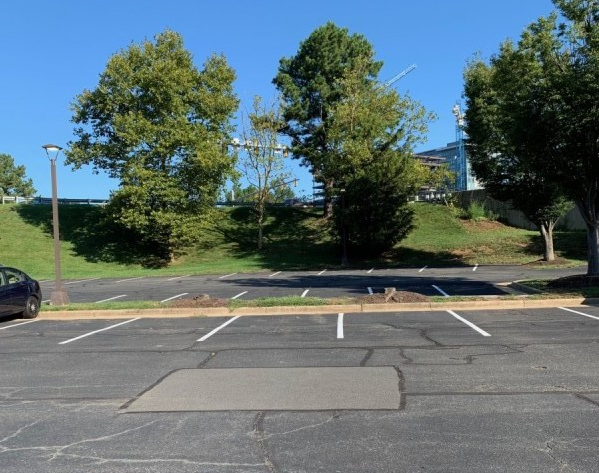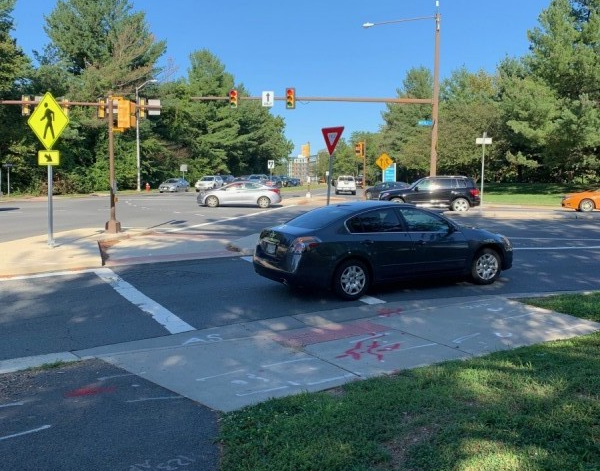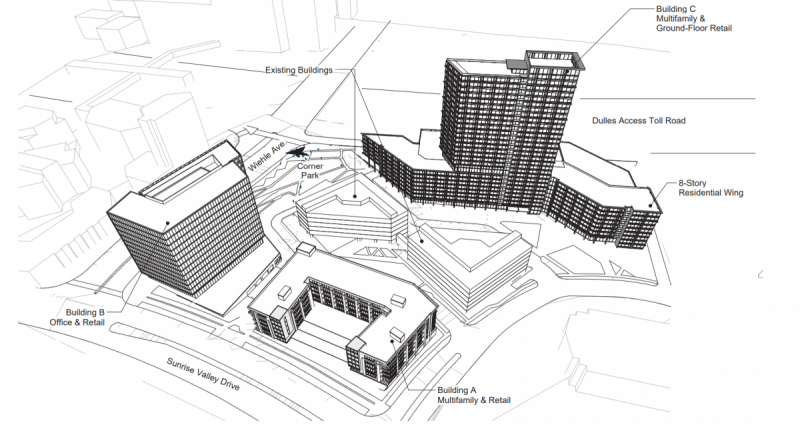Will Reston have communities and parks at its Metro stations, or parking lots?

New park space would bridge the gap between Wiehle Avenue and the ground level of Campus Commons in Reston. Image by Reston Association used with permission.
In Reston, fights over how the area should grow are on to a new round, this time over some parking lots just outside of a Metro station. A development proposed for an area near the Silver Line would include new office space, retail storefronts, and apartments, but one local group is not pleased.
Real estate developers TF Cornerstones wants to build on parking lots surrounding two existing office buildings at 1900 and 1902 Campus Commons Drive. My office is just down the street, also on Campus Commons Drive, outside the development area.
Sandwiched between the Dulles Toll Road, Wiehle Avenue, and Sunrise Valley Drive, Campus Commons is a large project that would add a large number of new homes and offices within close walking distance of the Wiehle-Reston East Station on Metro’s Silver Line. It’s part of a pattern being repeated up and down the Silver Line as its second phase nears completion.
The red marker shows the area where the Campus Commons project would go. Image created with Google Maps. 
Fairfax County wants its new growth to go near transit. By putting a large number of homes and offices close to Metro and near a major jobs hug, Fairfax can help lots of new people live and work there without adding many more car trips.
Arlington County has done this successfully and has provided a model for the rest of the region to follow. In Reston, these areas (known as a “Transit Station Area” or a TSA) are where development is expected to be most dense because of their proximity to the Dulles Toll Road and the Silver Line.
A rendering of the proposed development. Everything that surrounds the 'Existing Buildings' today is a parking lot. Image by Reston Association used with permission.
Still, there is some opposition. That’s not unexpected in Reston, where controversies over development and the area’s future has dominated public conversations for the last several years. In previous debates, there was a sense that Reston was doing enough to accomodate new people by simply building the Silver Line and adding density close to those stations. Now even this has come into question.
Taking a cue from “Rescue Reston,” a local group dedicated to preventing changes to two local golf courses, there’s a new group named “Rescue Sunrise Valley” focused on the area near Sunrise Valley Drive and Campus Commons. This second group is using the same type of language as the first: On the surface, it presents arguements about the planning process and traffic, but it’s clear that its ultimate goal is to fight broader changes in Reston.
Questions about process
One of the group’s main complaints is that developers have not been forthcoming about the project. According to Rescue Sunrise Valley, the developers “admitted” to not engaging with neighbors early enough. “NO WONDER THEY DIDN’T ASK THE NEIGHBORS WHAT WE THOUGHT!”, a header blares. There’s just one problem: A story in Reston Now details a number of public meetings about the project over the past two years.
Plus, this area is where the community agreed to add density. A six-year process (started in 2009 and wrapped up in 2015) known as the Reston Master Plan established the TSAs, and it offered many opportunities for residents to weigh in. The Master Plan can’t show what individual developments would look like (that’s up to the people who actually own the land), but it’s absolutely clear that big changes are planned for parcels close to Metro.
Plans for the development have worked their way through the Reston Association, the quasi-governmental body that governs much of the day-to-day in Reston. A meeting with the Fairfax County Planning Commission, the body that controls land use and zoning in Reston, is scheduled for September 25. The full Fairfax County Board will ultimately approve or deny the application sometime after that.
Crafting a process that gives plenty of notice and chances for input from the community is a big challenge. However, Reston had a long process with many opportunities for input, plus it has an extra level of review from the Reston Association before things are sent up to the county level. It’s true that the process can miss a lot of groups, but homeowners (like those in the “rescue” groups) are almost never one of them. In fact, homeowners are usually overrepresented in public meetings, to the detriment of other groups who also have a stake.
Complaints about traffic (and crosswalks)
Opponents also raised concerns about the amount of traffic the plan would bring. They say Sunrise Valley is already gridlocked, and a plan that adds homes and more offices to the area could lead to other issues like “cut-through” traffic through some of the nearby neighborhoods.
The group claims a crosswalk across Wiehle Avenue is the only transportation feature being built to handle new residents. It’s slated to be installed closer to the Dulles Toll Road entrance ramps, and would cut the walk to the Metro by about half the distance. The current walk requires some backtracking if you’re not willing or able to cut through a parking lot or navigate an area that lacks sidewalks. But Rescue Sunrise Valley argues the crosswalk plan would be too dangerous for people walking.
Right now if you want to get to where the proposed crosswalk will be, first you'll need to climb this steep bank and then run across a break in traffic. The project would replace it with a terraced path. Image by the author.
Traffic is bad on Sunrise Valley Drive, and crossing Wiehle Avenue can be a fraught experience. If I want to walk to the Metro from my office today I have to negotiate two separate travel islands to cross at the existing crosswalk. Sunrise Valley sees epic backups, which exist in part because it’s one of the few roads in the southern half of Reston that actually go anywhere. That’s exactly why it’s so important to add infrastructure for people walking, plus this crosswalk would help people get to the Metro safely.
Crossing at Wiehle and Sunrise Valley today isn't easy. Fairfax County eventually wants to remove the slip lanes which can encourage speeding through the intersection without checking to see who might be crossing on foot. Image by the author.
But claims that “just” a crosswalk is being built to handle the additional transportation demand is misleading. The biggest transportation asset, Metro’s Silver Line, is just a short distance away. Bus service is frequent along this stretch of Sunrise Valley thanks to the 551/553/RIBS 2/and 507 bus as well, even before you get to the many bus stops at the Metro station itself. Plus, the Fairfax County Bike Master Plan calls for protected bike lanes along Wiehle.
“Manhattanization” scare tactics
Oher language on Rescue Sunrise Valley’s website indicates that the group’s opposition isn’t really about crosswalk design. It uses descriptions like “crammed” buildings and “logjammed” traffic, and calls the new crosswalk “dangerous.”
It also points out that the project is being built by a “New York City developer,” a common trope used to spread fear, uncertainty, and doubt about new projects. In the past, Restonians opposed to development have resorted to fudging numbers to make unfavorable density comparisons to Manhattan. Ironically, Bob Simon, Reston’s celebrated founder, was from New York City.
How tall the new buildings at Campus Commons will be. Image by Reston Association used with permission.
While there are lots of challenges at Wiehle Avenue, they’re not because of pernicious influence from New York City developers. Rather, years of decision-making that prioritized the fast movement of cars through the area at the expense of everyone else have led to the situation we see now.
Old battles on new battlefields
One of the popular refrains during Reston’s zoning debates is that the code allowed too much density outside of areas near Metro stations. It wasn’t that people were against change, just that things should go where the impacts aren’t so noticeable in established neighborhoods. In a letter to RestonNow, Terry Maynard, one of the leaders against the proposed changes, wrote: “No community representative, then or now, has opposed reasonable residential and commercial development in the transit station areas.”
Yet now all the same objections are back, despite the earlier assertion that growth should just be near Metro. Is the only “reasonable” option really to do nothing?
Doing nothing won’t solve the problems facing Reston as the area grows, nor will stopping development near transit. It will, however, almost certainly make things worse. Restonians might have the power to prevent new buildings from being built, but they can’t stop people from moving to the area to take a new job or raise a family.
Campus Commons is the exact type of project the Reston Master Plan envisioned. Groups that wanted most of the growth to be close to Metro and not in other areas asked for this type of project. Nothing is being taken away with the construction of these new buildings except a few parking lots—a good exchange for new homes, offices, and park space.
If we can’t build there, where can we?
